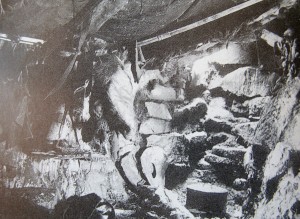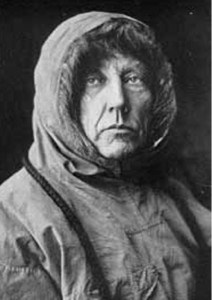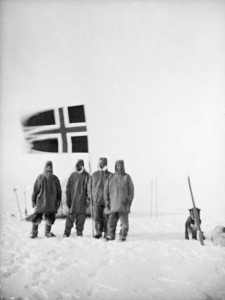AMUNDSEN CENTENARY CELEBRATIONS 1
In my first blog, Scott the Clot?, I mentioned the Bowden family’s brush with Antarctic fame in 1912 in Hobart – when my grandfather, Frank Bowden, who at that time was Manager for Telegraphs at the Hobart Post Office, was entrusted with the telegram from the Antarctic explorer Roald Amundsen to King Haakon of Norway that he had beaten Captain Robert Falcon Scott in the race to be the first to the South Pole.
Amundsen arrived in the Derwent River on 12 March 1912 in the little double-ended wooden schooner Fram in which his mentor, Fridjtof Nansen had used in 1893 to attempt to reach the North Pole by locking the specially designed vessel into the sea ice to drift close enough to the pole to reach it by dog sled.
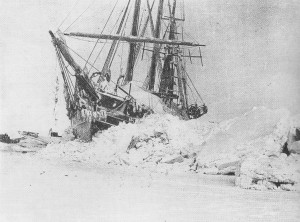
Fram frozen in the pack ice during its epic voyage to try and drift across the North Pole from 1893-96. Photo: H Aschehoug & Co
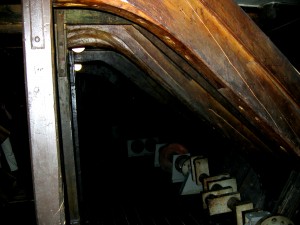
Fram is now permanently housed in its own museum in Oslo. Below decks I photographed the massive oak ribs that enabled this remarkable ship to resist the extraordinary pressure of the Arctic pack ice.
Fram remained locked in the ice for three years, its oak ribs stoutly resisting the attempts of the pack ice to crush it, before returning to Norway with its crew fit and well, but without their leader Nansen, who with a companion Hjalmar Johansen, had left the safety of the ship to try to ski to the North Pole when it became apparent the drift was not going to be close enough for the original plan to succeed.
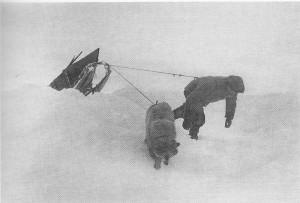
Johansen shown returning from the North Pole attempt, hauling his sledge over the pressure ridges with the aid of one dog, to reach open water. Photo: H Aschehoug & Co
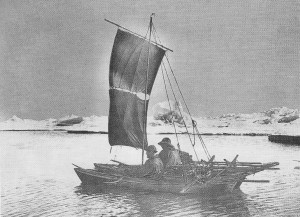
In this reconstructed photograph Johansen (nearest the camera) show how they turned their sledges into kayaks, lashed together into a makeshift catamaran, while they searched the bleak shores of Franz Josef Land off Cape Flora looking for a site to set up their winter refuge. Photo: H Aschehoug & Co
That polar attempt failed because the parallel ice pressure ridges made it impossible, and Nansen and Johansen then had to turn their sledges into kayaks as the summer ice began to melt, and try and find some land to spend another winter before trying to get home.
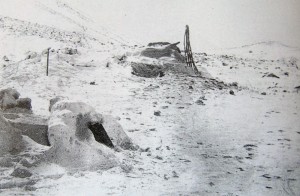
The entrance to the ice cave can be seen on the left. The walrus skin roof has been exposed by the heat from cooking on their improvised blubber stove. Photo: University of Oslo Library
They happened upon Franz Josef Land, and constructed a primitive ice cave using the skins of walruses as a roof, and stockpiling walrus and polar bear meat to last them through the winter. Burning blubber for light and to cook their food, they shared a double sleeping bag sewn from polar bear skins, to better resist the freezing temperatures. Although the two men got on well together, they soon exhausted their topics of mutual interest, and used to go for weeks at a time without speaking.
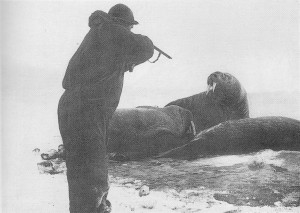
Johansen shooting a walrus for food. While on land walruses could be approached, but in the water they were fierce predators who attacked their makeshift kayak catamaran several times. Photo: H Aschehoug & Co
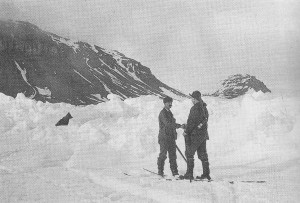
A posed photograph of the fortuitous meeting between Nansen (right) and Frederick Jackson, shown welcoming him to his base at Cape Flora. Photo: H Aschehoug & Co
Emerging in the Spring of 1896 Nansen had a miraculous chance meeting with an English explorer, Frederick Jackson – who curiously enough had been refused permission to go on Fram’s original voyage because he wasn’t Norwegian! Jackson organised his own Arctic expedition – fortunately for Nansen and Johansen – and their unlikely meeting is in the great tradition of ‘Dr Livingstone I presume’ exploration classics. (Nansen’s expedition is a ripping yarn in itself, and I suggest that you read either his own account of it, Farthest North, or a more recent book by Roland Huntford simply titled Nansen.)
The point is, however, that Nansen had lent Fram, (by then an extremely famous vessel) to Amundsen to attempt to drift across the NORTH Pole, as he had tried to do so many years before. Unfortunately for Amundsen no sooner had he began to outfit his expedition, not one but two men claimed to have already reached the North Pole – both Americans, Dr Frederick Cook, and Robert Peary.
As it happened, neither had done so, but this took years to resolve. But the news that the pole had been conquered left Amundsen rather flat-footed. He decided that he’d try for the South Pole instead, but kept his plans secret not only from Nansen, but everyone else except his trusted brother Leon Amundsen.
This was deception on a grand scale, particularly to Nansen who had himself harboured ambitions to tackle the South Pole using Fram, but whose fame and busy life as a scientist and international diplomat had made it all but impossible. Nevertheless telling him of his change of poles was not a risk Amundsen chose to take.
During the preparations for the voyage questions might have been asked why it was necessary to take such a large prefabricated wooden hut to the Arctic sea ice – it would be Amundsen’s base hut at the Bay of Whales in Antarctica – but somehow this was not queried.
Leon Amundsen took a commercial passage to Madeira where he planned to meet Fram, which arrived in the Funchal Roads on 6 September, 1909. Not any of Roald Amunden’s crew had any notion they were about to head south. As they sailed from Madeira on 9 September, Amundsen dropped his bombshell. They were going to the South Pole. Such was his leadership and force of personality that the entire ship’s company agreed to go. It was Leon’s sensitive mission to break the news first to the King and Nansen, and then the rest of the world – including Captain Scott who then knew that his attempt on the South Pole had turned into a race.
The rest, as they say, is history. Amundsen and his four companions and their husky dogs effectively cantered to the South Pole and back to their base camp called Framheim, built with some risk on an ice shelf at the Bay of Whales. They actually put on weight during the journey!
Scott, adhering to the brutish tyranny of man-hauling to which British explorers seemed addicted, reached the pole to find Amundsen’s distinctive tent signalling his triumph, and Scott’s party with not enough food or heating oil, perished with his four companions well short of their longed for One Ton Depot, which Scott himself had ordered be placed 100 miles short of its intended position because he could not stand the suffering of the ponies hauling the supplies.
Their bodies were not found until the Spring, on 12 November 1912. Scott might have been a poor expedition organiser, but he was a brilliant writer. The diary extolling the noble self-sacrifice of it all captured the imagination of the world, and ensured that Roald Amundsen, the man who got it right and got all his men back alive and well, was to be the victim of Scott’s posthumous legacy – the impertinent foreigner who had the temerity to snatch the first footing of the South Pole from this Gallant English Gentleman. The English speaking world largely lost interest in Amundsen after that, and he remained in Scott’s shadow really, for the rest of his life.
During which, I might add, he (and his South Pole companion Oscar Wisting) became the first men to visit BOTH poles, after they flew over the North Pole in an airship with the Italian aviator Umberto Nobile in 1926. (The American flyer Admiral Byrd claimed he had been the first to fly over the North Pole in his Fokker F-VII two weeks earlier, but his claim was later proved to be fraudulent.)
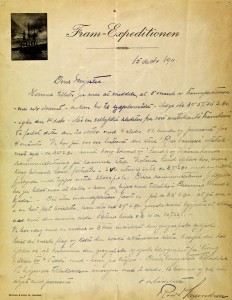
Letter to King Haakon of Norway written by Amundsen at the South Pole. Courtesy Norwegian National Library
HAVARD TOMMERAS’ TRANSLATION OF THE LETTER WRITTEN TO KING HAAKON OF NORWAY BY ROALD AMUNDSEN AT THE SOUTH POLE ON 15 DECEMBER 1911
Your Majesty
Hereby I allow myself to communicate that 5 men from the Fram expedition, among them myself, came here to the South Pole area yesterday the 14th of December, according to observations 89 57 30 southern latitude. We had a successful sledge ride from our winter base camp Framheim. We left this one on the 20 of October with 4 sledges, 52 dogs and food for 4 months. We have on our way passed the great Ross barrier extension southwards – ca.86 southern latitude – and King Edward Land and Victoria Land association on the same place. Victoria land stops here and King Edwards Land continues in the southwest direction until ca.87 southern latitude with an impressing mountain range that has peaks of ca. 22 000 feet. I have allowed myself with your permission to call these mountain ranges Queen Mauds ranges.
At 88 southern latitude the great glaciers went over to be at flat plateau and at 89 southern latitude this started to lean slightly downwards. The plateau is about 10 750 feet.
We have today with a radius of 8 km marked the geographic South Pole. We have hoisted the Norwegian flag and called this part of the plateau for King Haakons Plateau. I hope the king gives his permission to this.
We start the return trip tomorrow with 2 sledges, 16 dogs and well-equipped with provisions.
Respectfully
Roald Amundsen
(POSTSCRIPT: This letter was left at the South Pole,together with a letter to Captain Scott, presumably so he would take it back with him to England for delivery. This was somewhat delayed after Scott and his party perished, and was not found until November 1912. However the letter did eventually reach Norway’s King Haakon, but has only recently been located.)
In 2004, with the permission of the Bowden family, my wife Ros and I travelled to Oslo to present my Aunt Nora’s schoolgirl diary with the famous signatures to the Fram Museum, where Fram is permanently preserved. While in Oslo, we were able to visit Nansen’s grand house, and Amundsen’s more modest wooden cottage.
(An account of this journey can be seen under Travel on this site. Just follow the links to Polar, and ‘Footsteps in the Snow’.)
In 2011 I was contacted by a Norwegian, Havard Tommeras, who had read about the Bowden family connections with Amundsen on my website, and who said he was planning to come to Hobart to stay in Hadley’s Hotel (where Amundsen, dressed in his rough seaman’s clothing had said he was given a small room ‘and treated like a tramp’. Havard planned to do it in more style, by staying in what is know known as the Amundsen Suite.
Havard was keen to explore Hobart’s Amundsen connections, and had heard of some Amundsen descendants living in Burnie, on the north-west-coast of Tasmania. He had also tracked down one Bill Stephenson, whose grandfather had been in partnership with the famous Hobart photographer John Beattie, who not only photographed Fram while in Hobart and her crew, but had developed under great secrecy, Amundsen’s glass plate negatives of his South Pole adventure. Bill, it turned out, had not only a great collection of historic prints and negatives, but also some direct copies of the Amundsen photographs – and the historic enlarging and printing machinery from the original Beattie studio.
There was also a famous bronze bust of the Norwegian explorer at the University of Tasmania, one of only three in the world, which he wanted to see. I flew down to Hobart to meet him, and help realise these ambitions.
To my great surprise I also learned that Havard had organised the making of a full-sized tent similar to the one left at the South Pole that was to prove such a shock to poor Captain Scott when he saw it, and realised he had lost the race to the pole. ‘Great God, this is an awful place’, he wrote in his diary. But it had not seemed to Amundsen and his four companions, who stayed at the pole for some days to make quite sure that their calculations had them in the right spot.
Havard was planning to fly to the South Pole, after leaving Hobart, to join in a big Norwegian contingent celebrating the 100 year anniversary of Amundsen’s triumph and also put up his tent. Which he did! But more of that later.
When he reached Hobart, Havard wanted to practice putting the tent up, before he got to the South Pole. He had explored Hobart for a few hours before we met, and decided that a patch of grass in front of a rather imposing sandstone building on the Hobart waterfront would not only be a good place to pitch it, but provide a good picture opportunity with the docks in the background. I told him that his chances of succeeding on the front lawn in front of what was Tasmania’s State Parliament would probably have him arrested in seconds, as it might be thought he was making some kind of political statement. ‘Oh no, not another tent embassy’…
So I suggested St Davids Park nearby, where he managed to put up his curiously shaped tent without being stopped by any officialdom, helped by one Rod Ledingham, an Antarctic veteran of great experience who gave him a few tips on securing it in a blizzard. (Rod was destined to play the part of Roald Amundsen the following March on the anniversary of Fram’s arrival in Hobart, giving his momentous telegram to me on the steps of the Hobart Post Office, deputising for my long-dead grandfather, Frank Prosser Bowden, then Manager for Telegraphs).
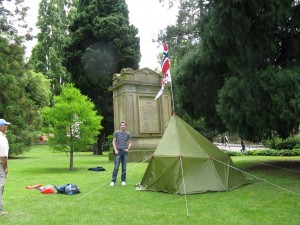
Havard Tommeras manages to pitch his tent in St Davids Park, Hobart, without triggering a diplomatic incident.
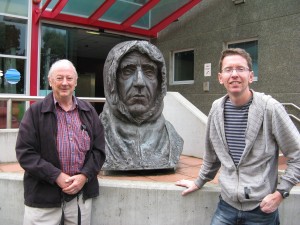
Tim Bowden (left) and Havard Tommeras beside a rare bronze bust of Roald Amundsen on the campus of the University of Tasmania.
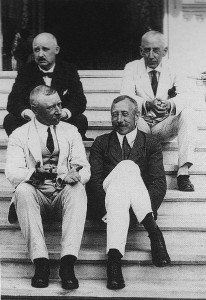
The Amundsen brothers in 1918. Rear from left: Gustav and Roald. Front row from left: Jens and Leon.
Before Havard arrived I managed to track down the Amundsens in Burnie. It seems that Robin ‘Rocky’ Amundsen moved to Tasmania from Adelaide, where his family had lived for some time. Roald Amundsen himself never married and had no descendants, although there may be offspring not known about as he was something of a ladies man, as they say. He had three older brothers, Jens, Gustav and Leon, and the Burnie Amundsons are trying to trace which brother might be their ancestor. Havard met the Amundsens in Hadleys Hotel just before he left Hobart.
STILL TO COME…
Havard’s adventures at the South Pole – where he nearly missed putting his tent up at all, because it was put on the wrong aircraft by mistake!

